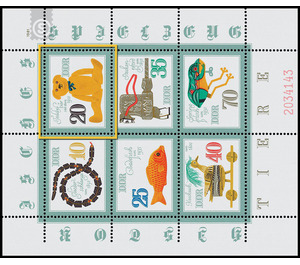Commemorative stamp series - Germany / German Democratic Republic 1981 - 20 Pfennig
Theme: Animals
| Country | Germany / German Democratic Republic |
| Issue Date | 1981 |
| Face Value | 20.00 |
| Color | grey red |
| Perforation | K 13 1/2: 13 |
| Printing Type | offset |
| Stamp Type | Postage stamp |
| Item Type | Stamp |
| Chronological Issue Number | 2404 |
| Chronological Chapter | GER-DDR |
| SID | 193436 |
| In 14 Wishlists | |
Historical Toys - Animals With illustrations of historical toy animals, the Ministry of Posts and Telecommunications of the German Democratic Republic publishes six multicolored special postage stamps printed together on a miniature sheet. No special first day cover envelope Special cancellation from 24th November 1981 to 23rd January 1982 Historic toys - animals Play animals occupy an important place in the motif treasure of the toy today as ever, because their role models are an important part of our environment. They awaken and promote in the child the knowledge of the meaning of the animal for humans, whether as part of the surrounding nature, as a useful pet or as a comrade and playmate. The game animals selected for the special postage stamp issue may stand for this finding. Over a period of two hundred years, to which these testimonies belong, different materials and technical means have been used to design the characteristics of different animals and to develop manageable toys. For many decades, the teddy bear (20-pfennig value) is a particularly amiable toy. Not by chance, the stuffed or plush bear became the darling of countless children. The ground for this was already prepared by the position of the bear in the life of the people, let us think of the master Petz as a hero of many fairy tales, folk tales or fables, to the demonstration of dancing bears at folk festivals and trained circus bears. In the GDR, teddy bears are produced in addition to a variety of other stuffed animals, especially in toy factories of the Sonneberg area. This special postage stamp issue gives a small outline of the history of the toy since 1800 on the basis of six motifs and shows the change that has taken place in these two hundred years.


